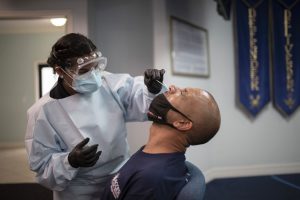Compensating the families of Black Californians who were scarred by slavery is a delicate, complex and controversial task — as the unprecedented state panel pondering the issue is finding out.
After hours of testimony by experts and heated debate amongst its nine members, the California task force on reparations decided in a 5-to-4 vote to limit the eligibility for compensation to Black Californians who can trace their lineage back to free or enslaved ancestors living in the United States before the end of the 19th century.
Reparations should be focused on addressing those whose families were directly affected by the era of slavery, instead of the wider problem of racism that Black people experience.
The “fact that California is taking the first steps toward reparations for slavery is a major milestone,” Justin Leroy, an assistant professor at UC Davis whose research specializes in the history of slavery and emancipation, said of the March 29 vote.
Some on the task force argued that all 2.6 million Black Californians be eligible for reparations, while still giving “special consideration” to those with free or enslaved ancestors.
But the narrow majority recommended that reparations should be focused on addressing those whose families were directly affected by the era of slavery instead of the wider problem of racism that Black people experience.
By one projection presented to the panel said that to close the wealth gap could cost a staggering $672 billion.
Determining that is clearly a daunting task, entailing in part searches through old — and often incomplete –19th and 20th century records of births, deaths, taxes, census reports, military and government service, property documents, travel, and the like.
Estimates of a price tag for reparations vary widely. By one projection presented to the panel said that to close the wealth gap could cost a staggering $672 billion, if paid to those with free or enslaved ancestors living in the U.S. before the end of the 19th century.
Assembly Bill 3121, the legislation that set up the task force to study and develop a proposal for reparations, was signed by Gov. Newsom in the wake of the George Floyd protests in 2020.
The panel of experts and lawmakers are expected to come up with a plan by June 2023 recommending who should get reparations, what forms those reparations come in, and how much people receive.
The panel plans to release its findings on the history of slavery and its effects this June.
“The fact that we all came in, whether on a slave ship or a cruise ship — guess what? We’re all in the same boat now.” — Reginald Jones-Sawyer
Task force chair Kamilah Moore supports lineage-based reparations, which she says was the intent of the legislation, authored by Shirley Weber, a former lawmaker and current secretary of state.
In a January meeting of the task force, Weber seemed to confirm that, saying, “reparations are for those who are the descendant of slaves first, because of the devastation they suffered from hundreds of years of no wages and no ability to own land and accrue wealth.”
Assemblymember Reginald Jones-Sawyer, (D-Los Angeles), one of the co-authors of the original bill and a member of the task force, said the bill’s intent was not as clear as others claimed it to be.
Jones-Sawyer argued that the legacy and effects of slavery have touched all Black Californians, regardless of how their families ended up in the United States.
“We can’t go into this reparations proposal without having all African-Americans in California behind us.” — Lisa Holder
“The fact that we all came in, whether on a slave ship or a cruise ship — guess what? We’re all in the same boat now,” Sawyer said.
Lisa Holder, a civil rights lawyer who helped lead the Prop 16 campaign to repeal California’s ban on affirmative action, also disagreed with a lineage-based approach.
Such an approach, she argued, would exclude nearly 30% of the 2.6 million Black people in California from this proposal would create division at a time that they needed to build consensus.
“We can’t go into this reparations proposal without having all African-Americans in California behind us,” she said. “That’s going to undermine consensus and that’s going to undermine the success of this policy. We have to make sure we are focusing more on belonging than ‘otherizing’…”
Leroy said that the question of race vs. lineage when it comes to reparations is complex.
“There are good reasons for distinguishing between descendants of enslaved people and Black immigrants, because there is some evidence to suggest that West Indian and African immigrants have more social mobility than descendants of enslaved people,” he said.
But Leroy said the effects of anti-black racism are felt by both those who are direct descendants of enslaved people and those whose families immigrated to the United States.
“I think part of the problem is how we envision reparations. If you think of it as monetary compensation…then the question of who deserves to benefit is important, and of course you’re going to run into this problem of whether or not all Black people should benefit,” he said.
“But monetary compensation for individuals or families would be really low on my list of ideas for how reparations should function.”
Instead, he added, an important focus should be to invest in Black neighborhoods. Investing in things like schools, jobs, healthcare, and childcare would undo slavery’s legacy of devaluing Black life and serve as a more productive way of doing reparations, he said.
Want to see more stories like this? Sign up for The Roundup, the free daily newsletter about California politics from the editors of Capitol Weekly. Stay up to date on the news you need to know.
Sign up below, then look for a confirmation email in your inbox.




